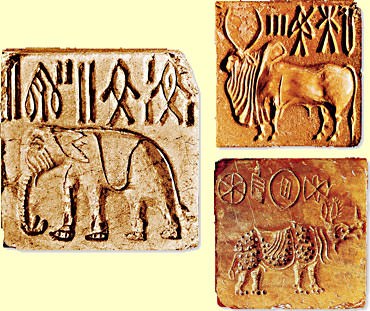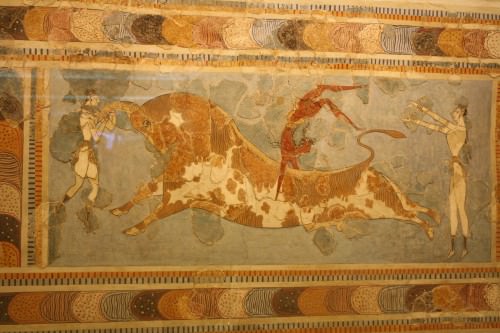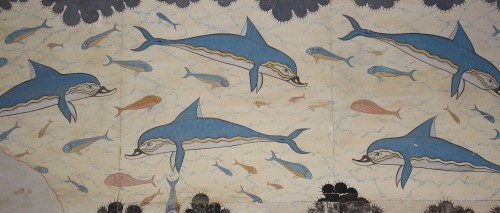Indus Valley Civilization › Minoan Frescoes » Ancient origins
Articles and Definitions › Contents
- Indus Valley Civilization › Ancient History
- Minoan Frescoes › Antique Origins
Ancient civilizations › Historical and archaeological sites
Indus Valley Civilization › Ancient History
Definition and Origins

The Indus Valley Civilization was an ancient civilization located in what is Pakistan and northwest India today, on the fertile flood plain of the Indus River and its vicinity. Evidence of religious practices in this area date back approximately to 5500 BCE.Farming settlements began around 4000 BCE and around 3000 BCE there appeared the first signs of urbanization. By 2600 BCE, dozens of towns and cities had been established, and between 2500 and 2000 BCE the Indus Valley Civilization was at its peak.
THE LIFE OF THE INDUS VALLEY CIVILIZATION
Two cities, in particular, have been excavated at the sites of Mohenjo-Daro on the lower Indus, and at Harappa, further upstream. The evidence suggests they had a highly developed city life; many houses had wells and bathrooms as well as an elaborate underground drainage system. The social conditions of the citizens were comparable to those in Sumeria and superior to the contemporary Babylonians and Egyptians. These cities display a well-planned urbanization system.
THE EVIDENCE SUGGESTS THEY HAD A HIGHLY DEVELOPED CITY LIFE; MANY HOUSES HAD WELLS AND BATHROOMS AS WELL AS AN ELABORATE UNDERGROUND DRAINAGE SYSTEM.
There is evidence of some level of contact between the Indus Valley Civilization and the Near East. Commercial, religious, and artistic connections have been recorded in Sumerian documents, where the Indus valley people are referred to as Meluhhaites and the Indus valley is called Meluhha. The following account has been dated to about 2000 BCE: "The Meluhhaites, the men of the black land, bring to Naram-Sin of Agade all kind of exotic wares." (Haywood, p. 76, The Curse of Agade)
The Indus Civilization had a writing system which today still remains a mystery: all attempts to decipher it have failed. This is one of the reasons why the Indus Valley Civilization is one of the least known of the important early civilizations of antiquity.Examples of this writing system have been found in pottery, amulets, carved stamp seals, and even in weights and coppertablets.
Another point of debate is the nature of the relationship between these cities. Whether they were independent city-states or part of a larger kingdom is not entirely clear. Because the writing of the Indus people remains undeciphered and neither sculptures of rulers nor depictions of battles and military campaigns have been found, evidence pointing in either direction is not conclusive.
DECLINE OF THE INDUS VALLEY CIVILIZATION
By 1800 BCE, the Indus Valley Civilization saw the beginning of their decline: Writing started to disappear, standardized weights and measures used for trade and taxation purposes fell out of use, the connection with the Near East was interrupted, and some cities were gradually abandoned. The reasons for this decline are not entirely clear, but it is believed that the drying up of the Saraswati River, a process which had begun around 1900 BCE, was the main cause. Other experts speak of a great flood in the area. Either event would have had catastrophic effects on agricultural activity, making the economy no longer sustainable and breaking the civic order of the cities.

Indus Valley Seals
Around 1500 BCE, a large group of nomadic cattle-herders, the Aryans, migrated into the region from central Asia. The Aryans crossed the Hindu Kush mountains and came in contact with the Indus Valley Civilization. This was a large migration and used to be seen as an invasion, which was thought to be the reason for the collapse of the Indus Valley Civilization, but this hypothesis is not unanimously accepted today.
Thus, the Indus Valley Civilization came to an end. Over the course of several centuries, the Aryans gradually settled down and took up agriculture. The language brought by the Aryans gained supremacy over the local languages: the origin of the most widely spoken languages today in south Asia goes back to the Aryans, who introduced the Indo-European languagesinto the Indian subcontinent. Other features of modern Indian society, such as religious practices and caste division, can also be traced back to the times of the Aryan migrations. Many pre-Aryan customs still survive in India today. Evidence supporting this claim includes: the continuity of pre-Aryan traditions; practices by many sectors of Indian society; and also the possibility that some major gods of the Hindu pantheon actually originated during the time of the Indus Valley Civilization and were kept "alive" by the original inhabitants through the centuries.
Minoan Frescoes › Antique Origins
Ancient Civilizations
Frescoes are the source of some of the most striking imagery handed down to us from the Minoan civilization of Bronze Age Crete (2000-1500 BCE). Further, without written records, they are often the only source, along with decorated pottery, of just how the world appeared to the Minoans and give us tantalizing glimpses of their beliefs, cultural practices and aesthetic tastes.

Minoan Bull Leaping
TECHNIQUES & COLOURS
Inherent problems with frescoes are their fragility, incompleteness and artistic anonymity. In addition, in archaeological sites they are often found removed from their original settings, making them extremely difficult to date. Perhaps, restoration has at times been over-imaginative but nevertheless, the overwhelming impression given by this art form is the Minoan ’s sheer joy in fluid, naturalistic and graceful forms represented in an impressionistic manner. There are also many surviving fresco fragments dating from the second phase palaces of 1550 to 1450 BCE, when the Mycenaeans began to take over the Minoan sites.However, as these are stylistically very similar to earlier Minoan frescoes, they are discussed as one in the following remarks.
AS A TECHNIQUE, TRUE FRESCO PAINTING (BUON FRESCO) IS THE PAINTING OF COLOUR PIGMENTS ON WET LIME PLASTER WITHOUT A BINDING AGENT.
As a technique, true fresco painting (buon fresco) is the painting of colour pigments on wet lime plaster without a binding agent and when the paint is absorbed by the plaster it is fixed and protected from fading. That the Minoans employed such a technique in their buildings is evidenced by string impressions in the plaster and by the depth of the paint employed. Fresco secco, which is the application of paint, in particular for details, onto a dry plaster was also used throughout the palaces as was the use of low relief in the plaster to give a shallow three dimensional effect. Colours employed were black (carbonaceous shale), red (haematite), white (hydrate of lime), yellow (ochre), blue (silicate of copper ), and green (blue and yellow mixed).There are no surviving examples of shading effects in Minoan frescoes, although interestingly, sometimes the colour of the background changes whilst the foreground subjects remain unchanged. Although the Egyptians did not use true fresco, some of the colour conventions of their architectural painting were adopted by the Minoans. Male skin is usually red, female is white, and for metals: gold is yellow, silver is blue and bronze is red.

Griffin Fresco, Knossos, Crete
FRESCO SUBJECTS
The first examples of fresco in Crete are limited to simple monochrome walls, most often red but sometimes also black. With improvements in the quality of plaster and pigments, the advent of monumental Minoan architecture and possibly through influence from Egypt and the Near East, the technique was employed to decorate the walls (either in their entirety, above windows and doors or below the dado), ceilings, wooden beams and sometimes floors of the palace complexes, depicting first abstract shapes and geometric designs and then later, all manner of subjects ranging in size from miniature to larger than life size.
As in earlier seal and ring engravings, popular scenes for frescoes - and perhaps indicative of the role of the palaces in Minoan society - were of rituals, processions, festivals, ceremonies and bull sports. Celebrated examples include two seated priestesses on either side of a shrine, a grove of olive trees with dancers and audience, two boxers, young men in a procession carrying rhytons, and a scene of both male and female figures in various stages of bull leaping - grasping the horns or somersaulting over the back of the animal. On occasion, fresco was also used to imitate architectural features, for example, veined alabaster slabs painted on the lower portions of walls.
Natural subjects included flowers such as lilies, irises, crocuses, roses, and also plants such as ivy and reeds. Indeed, the Minoans were one of the earliest cultures to paint natural landscapes without any humans present in the scene; such was their admiration of nature.
Animals were also commonly portrayed, most often in their natural habitat, for example, monkeys, birds, cats, goats, deer, sea urchins, dolphins and fish. Although Minoan frescoes were often framed with decorative borders of geometric designs (spirals, diagonals, rosettes, and 'maze' patterns), the principal fresco itself, on occasion, went beyond conventional boundaries such as corners and covered several walls, surrounding the viewer.

Dolphin Fresco, Knossos, Crete
Other objects which received the fresco treatment include the celebrated limestone sarcophagus from Hagia Triada, a rare example of a fresco surviving complete. Within decorated frames, different sides of the coffin show two goddesses, each in a chariot, one drawn by goats and the other by griffins, a scene of a bull sacrifice and a funeral scene.
LEGACY
The Minoan style in frescoes was influential both with contemporary cultures such as in the Cyclades (eg Akrotiri on Thera, Phylakopi on Melos and Hagia Irini on Keos) and with later cultures, especially the Mycenaean, albeit with slightly different subject matter such as shields and other martial paraphernalia and perhaps with a lesser importance given to naturalism.Indeed, as far afield as Tel el Dab'a in Egypt, frescoes have been discovered which are notable for their similarity in style to the Minoan.
LICENSE:
Article based on information obtained from these sources:with permission from the Website Ancient History Encyclopedia
Content is available under License Creative Commons: Attribution-NonCommercial-ShareAlike 3.0 Unported. CC-BY-NC-SA License